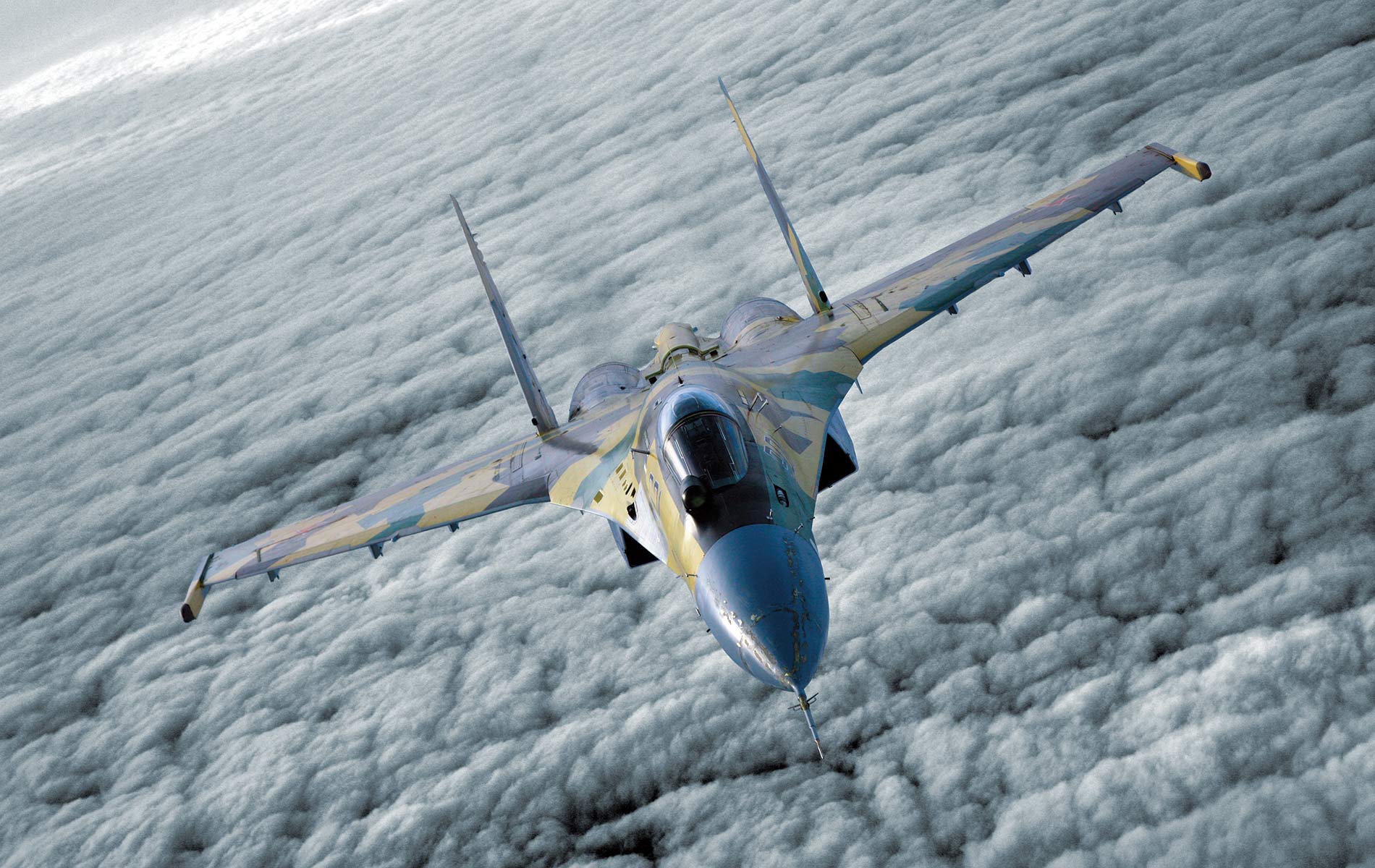
vie-magazine-codename-flanker
Codename: Flanker
By Bill Weckel | Photography courtesy of Sukhoi (JSC)
Since the Vietnam War, the U.S. Air Force has taken a tag-team approach to fighter strategy. The heavyweight F-15 Eagle, with its exceptionally high performance and long range, is combined with the smaller, lighter, and cheaper F-16 Fighting Falcon. Although most nations can’t afford it, the U.S. can, and it makes sense from both a military and a budgetary perspective. This tag team worked well in the Gulf War, the Balkans, and Iraq, and it continues to do so today in Afghanistan. The approach works so well, in fact, that we’re seeing it carried forward into the fifth generation of fighter aircraft development with the F-22 Raptor/F-35 Lightning II combo (although at $154 million a pop, the F-35 doesn’t exactly meet the “cheaper” criterion).
The Soviets saw the wisdom in this approach, too. Heavily influenced by the new record-breaking F-15 Eagle, the Soviet Union began development of its own heavy/light fighter combo: Mikoyan supplied the lightweight fighter in the form of the MiG-29, and Sukhoi, the heavyweight Su-27. MiG, the moniker for the Mikoyan-and-Gurevich Design Bureau, was practically a household name in the West, with MiG becoming the generic term for any Russian jet. MiG had been providing the Soviet Union with the bulk of its frontline fighters since the fifties.
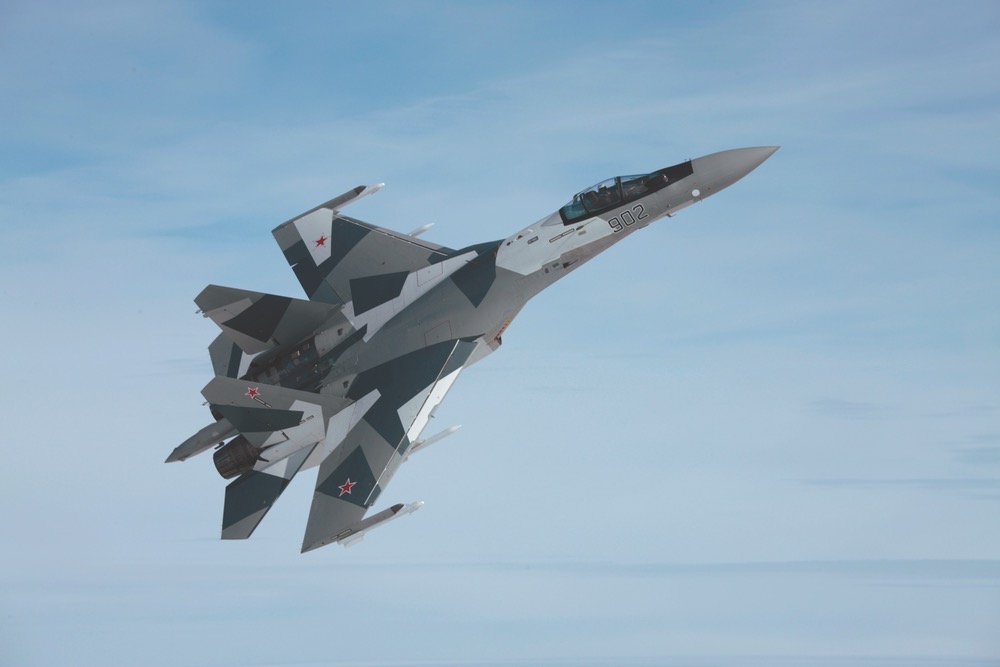
Sukhoi Su-35 fighter
Sukhoi was, at least beyond the Iron Curtain, a less familiar name. Although the Sukhoi bureau had been designing aircraft since 1939, it hadn’t produced an aircraft that captured both the public imagination and the attention of Western military intelligence until the 1970s. We (the intel community) tended to think of the Sukhois as the ugly little sisters of the sexier MiGs—hence, the general surprise when an early prototype was discovered by U.S. reconnaissance satellites. Dubbed the “Flanker” by NATO, the new Sukhoi was massive—as big as or bigger than the F-15. Like the Eagle, it had twin engines and twin tails. The West would later discover, however, that the aircraft design was quite innovative in other aspects. Like many of the Soviet submarines, the new Sukhoi was constructed using vast amounts of titanium, a resource the Soviet Union possessed in near limitless quantity. The Sukhoi achieves lift by way of a blended wing design and can perform seemingly impossible maneuvers such as zero-radius turns, somersaults, and near-hovers. Called the Zhuravlik (Crane) by Russians, Su-27s consistently steal the show at exhibitions and air shows around the world.
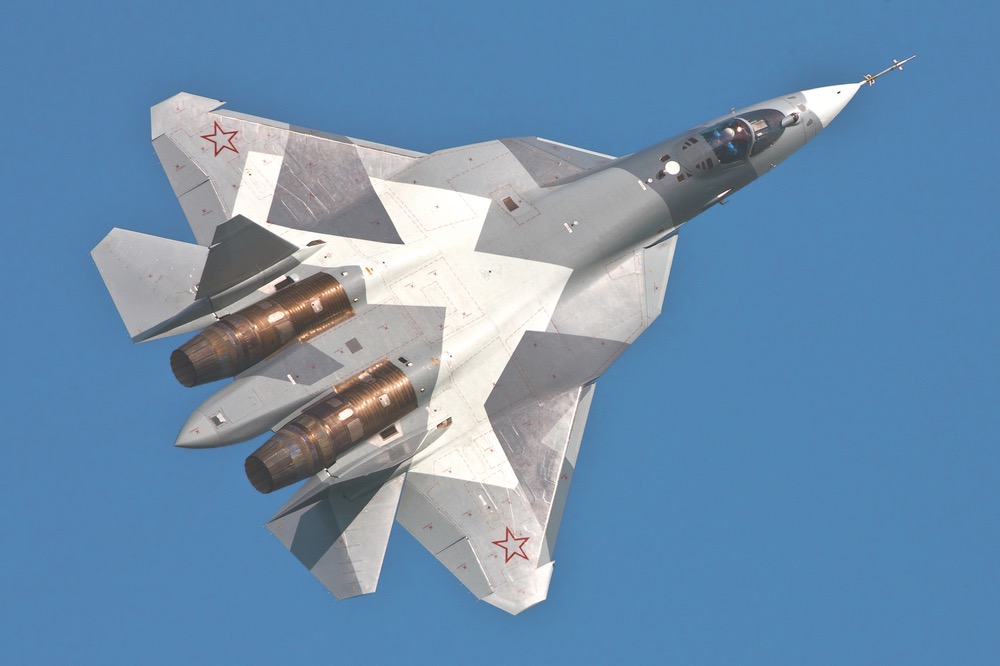
PAK FA fifth-generation fighter
Beyond the Sukhoi’s incredible maneuverability, it’s an outstanding weapons platform.
Not unlike many great aircraft, the Su-27 had troubled beginnings. Several fatal crashes marred its early development. Design flaws were identified and corrected, and the aircraft went into full production, providing the backbone of the Soviet fighter force. Beyond the Sukhoi’s incredible maneuverability, it’s an outstanding weapons platform. It can carry an enormous amount and array of air-to-air and air-to-ground weaponry. The aircraft had an Achilles’ heel, however. Its radar system was fraught with design and performance issues that weren’t resolved until later follow-on models.
Despite the radar issues, the Russians knew they had a winner in the Su-27. The aircraft would form the basis for a franchise of follow-on models: a navalized version of the Zhuravlik, with folding wings, arrestor hook, and reinforced landing gear, would defeat the MiG-29 in the competitive bid for Russia’s new carrier fighter.
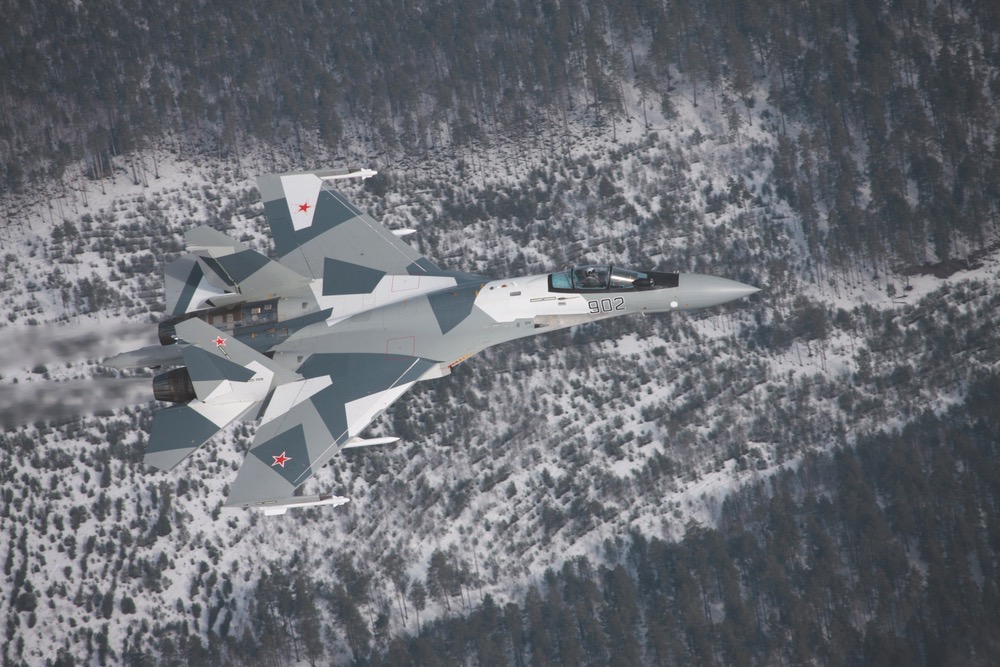
An Su-35 wearing a disruptive splinter camouflage scheme
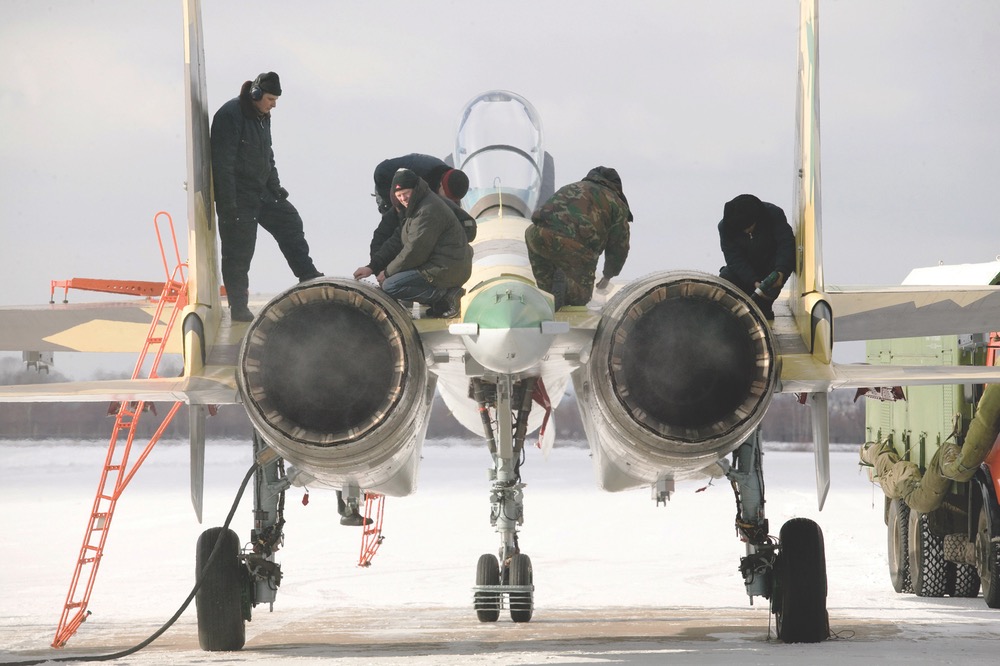
The Zhuravliki are very big birds!
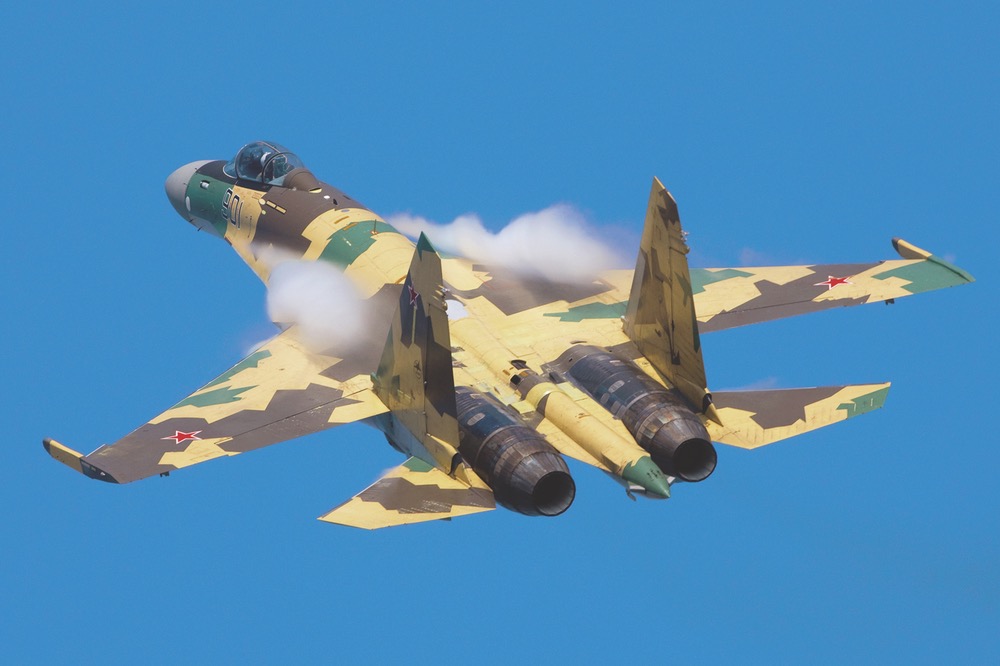
Sukhoi Su-35 fighter
The Sukhoi’s development has often paralleled that of the F-15. A two-seat, all-weather strike/interdiction variant, the Su-30, has been developed for both domestic use and export. The Su-30 and Su-34 strike versions are able to fight their way into the target area, defeat enemy fighters in air-to-air combat, attack their targets, and egress, all without the need for additional fighter escort.
The Sukhoi added supermaneuverability to its résumé with the addition of canards and thrust vectoring in the Su-35 and Su-37 models. The Su-37 Berkut is, arguably, the most maneuverable fourth-generation-plus aircraft in the world. It did not, however, reach production stage. Instead, Russia has chosen to focus its development efforts on a fifth-generation aircraft that will directly counter the West’s F-22 and F-35 threat. This fifth-generation “stealth” fighter is—you guessed it—a Sukhoi.
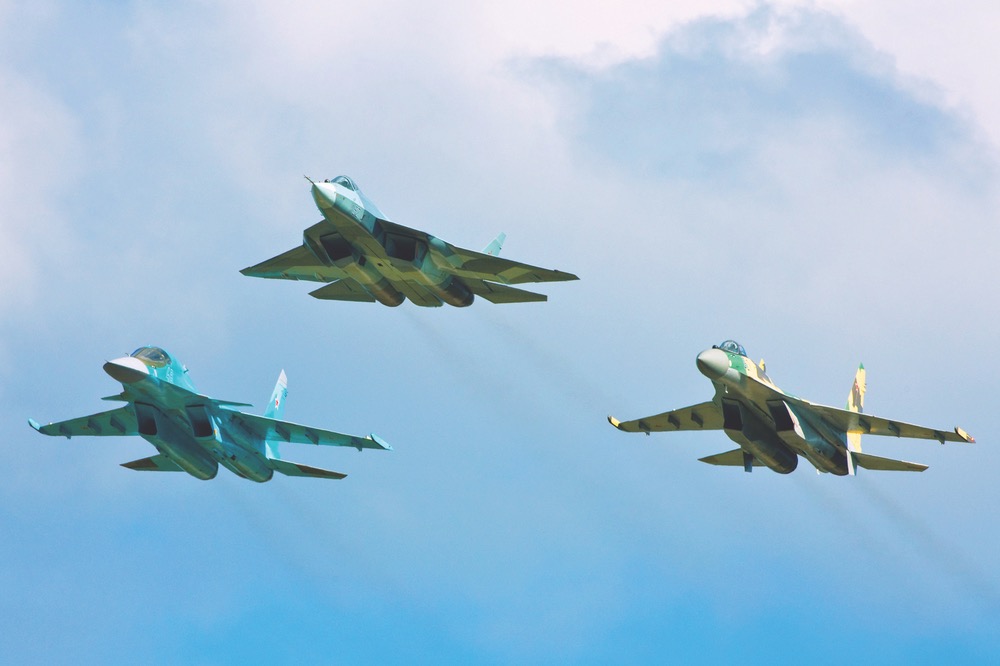
Left to right: Su-34, PAK FA, Su-35
Designated the T-50/PAK FA, Sukhoi’s newest fighter is designed to be supermaneuverable, have very low radar observability, and be capable of supercruise (mach one-plus speeds without the use of afterburner). While the T-50 shares many of the same capabilities as the F-22 Raptor, and, visually, is very similar, the Russians made significant departures from the F-22 approach. The T-50 sacrifices stealthiness for maneuverability. Its sticker price is also lower. Sukhoi can build three T-50s for every Raptor that Lockheed Martin delivers. At one-third the cost of its competitor, Russia can produce more aircraft for its own use and keep the aircraft affordable for potential export customers like India and Malaysia.
Su-27s and their offspring, numbering in the thousands, are currently serving in the air forces of more than a dozen countries. The Su-27 and MiG-29 aircraft families are the threats most likely to be encountered by U.S. and NATO pilots now and for decades to come.
— V —
Share This Story!
KEEP UP WITH THE LATEST STORIES FROM VIE


















































































































































